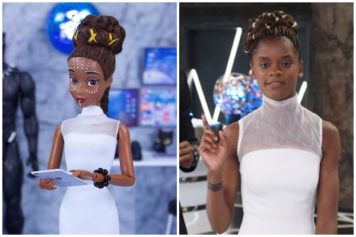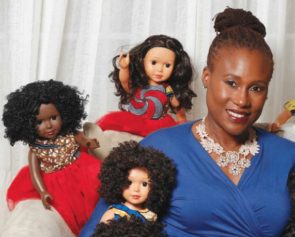Where are all the black dolls? Most little girls who played with Barbies or Cabbage Patch Kids an tell you that their dolls were usually white with blonde hair and blue eyes. Fewer dolls had darker hair, even fewer had dark hair and dark eyes, and almost none had dark skin.
Fortunately, there are some people who are fighting to put a stop to the lack of diversity in dolls that young women play with.
Sheri and Corey Crowley didn’t think much of the race of their daughters dolls until the noticed their beautiful little girls battling some serious self esteem issues.
At a young age the girls were able to notice that none of their dolls – which are often examples of beauty to most little girls – actually looked like them.
Needles to say when young girls grow up seeing many images of beauty but none that ever look like her, it makes her wonder “What is wrong with me?” “Why can’t I be beautiful?” “What did I have to look this way?”
The severity of the lack of diversity in children’s dolls became overwhelmingly apparent when the Crowley daughters headed to an American Girl Doll store for a birthday party.
The image of a black doll had already been tainted and even if they did want an African American doll, the only black option the store had was a freed slave doll.
After the family moved into a majority whit neighborhood the girls’ insecurities sky rocketed and suddenly they just couldn’t understand why they didn’t look like their dolls or the other girls in their class.
“She started asking me for products that she would see on TV,” the girls’ mother Sheri explained. “So if it was a Pantene commercial where she would see long blonde hair similar to her table mates, she would ask me to buy it thinking that it would change her hair.”
Sheri knew the shampoo wouldn’t change her daughter’s hair but she did have a way to changer her daughter’s perception.
She teamed up with her husband to create the “Pretty Brown Girl Movement” which will feature an entire collection of African American dolls. While the beautiful brown dolls were being manufactured, the couple had already begun spreading the word by creating a t-shirt line with the slogan “Pretty Brown Girl Movement.”
Some people may not see how serious it is for a young girl to have a doll that looks like her, but we have to understand that a doll is more than just a toy.
The things kids play with have a major role in socializing them and shaping their beliefs and values.
Think about the way a white Barbie has had several fun careers that little girls can aspire to be. The traditional Barbie doll – with white skin, blonde hair, and blue eyes – has been featured in every occupation from a doctor to a professional beautician.
What careers was the rare black Barbie obtained? A flight attendant, waitress, and the latest black Barbie doesn’t even have a job. She’s just a superficial doll holding tiny versions of designer hand bags with long blonde hair (that obviously isn’t natural to any African American woman) and a cleavage exposing outfit that makes her appear to be some sort of sex feign or Jezebel.
So these are the goals and aspirations that young black girls have to look forward to. When they day dream with the aid of their dolls they aren’t supposed to dream higher than being a flight attendant or some hoochie who has mysteriously obtained expensive goods without covering herself up? Meanwhile the Caucasian Barbies are helping young white girls have dreams of being teachers, lawyers, doctors, police officers, race car drivers, astronauts, beauty queens, and more.
One filmmaker had the pleasure of growing up with mostly African American dolls simply because her mother stood in long lines and put in special orders to receive the dolls of different ethnicities.
So you can only imagine her confusion when one of her friends finally asked her as a child, “Why do you have black dolls?”
As a child she didn’t really have an answer, but when she grew older she created a documentary that answered that very same question that had stuck with her throughout all those years.
The documentary, which is actually titled “Why Do You have Black Dolls,” exposes just how difficult it was for her mother to obtain the dolls of color and what implications the lack of a black doll has on many growing girls.
Needless to say it was quickly revealed that most of the girls saw the classic Barbie images as beautiful, but didn’t feel the same way about the black dolls.
For some girls, however, they were still simply overwhelmed and joyful to see a doll that had their eyes, skin color, hair, and facial features.
We may be old enough to know that a doll shouldn’t determine what is beautiful and what isn’t, but for a young impressionable girl growing up in a world full of imagination and wonder – why does a beautiful black doll have to be a part of that imaginative world rather than her reality?


